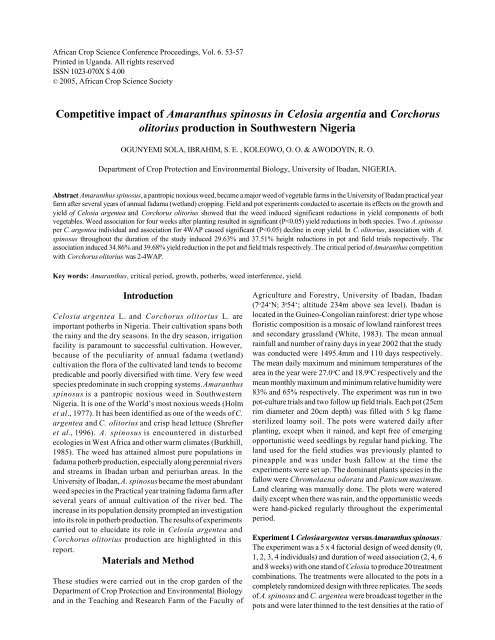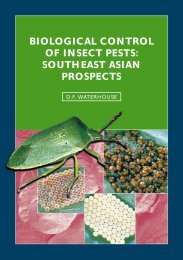Adobe PDF - EcoPort
Adobe PDF - EcoPort
Adobe PDF - EcoPort
Create successful ePaper yourself
Turn your PDF publications into a flip-book with our unique Google optimized e-Paper software.
African Crop Science Conference Proceedings, Vol. 6. 53-57<br />
Printed in Uganda. All rights reserved<br />
ISSN 1023-070X $ 4.00<br />
© 2005, African Crop Science Society<br />
Competitive impact of Amaranthus spinosus in Celosia argentia and Corchorus<br />
olitorius production in Southwestern Nigeria<br />
OGUNYEMI SOLA, IBRAHIM, S. E. , KOLEOWO, O. O. & AWODOYIN, R. O.<br />
Department of Crop Protection and Environmental Biology, University of Ibadan, NIGERIA.<br />
Abstract Amaranthus spinosus, a pantropic noxious weed, became a major weed of vegetable farms in the University of Ibadan practical year<br />
farm after several years of annual fadama (wetland) cropping. Field and pot experiments conducted to ascertain its effects on the growth and<br />
yield of Celosia argentea and Corchorus olitorius showed that the weed induced significant reductions in yield components of both<br />
vegetables. Weed association for four weeks after planting resulted in significant (P
54<br />
1:0, 1:1, 1:2, 1:3 and 1:4 of C. argentea to A. spinosus. A distance<br />
of 6 cm was maintained between and among stands of combining<br />
species. In the field trial, the same treatment combinations<br />
were established but in a randomized complete block design<br />
with three replicates. Each block was 2 x 1 m 2 . The plots were<br />
bed-raised with hoes. The plots were 0.5m apart. Seeds of C.<br />
argentea were drilled at 15cm spacing between rows and later<br />
thinned to 15cm within rows to have a plant density of 444,444<br />
plants per hectare.. Seeds of A. spinosus were ring-broadcast<br />
at 6cm intervals and later thinned to the required density ratios<br />
at 2 WAP. The performance of both C. argentea and A. spinosus<br />
was monitored in terms of plant height, stem diameter, number<br />
of leaves/plant, leaf area and plant biomass at harvest.<br />
S. OGUNYEMI et al.<br />
Experiment II. Corchorus olitorius versus Amaranthus<br />
spinosus: The design of the experiment followed the two<br />
component model as described by Hall et al. (1992). The 1 st<br />
component is the maximum length of time weeds emerging<br />
with the crop can remain before they reduce yield (weedy and<br />
subsequently weedfree, wd-wf) and the 2 nd component is the<br />
length of time that a crop must be kept weed-free after planting<br />
so that weeds emerging later do not reduce yield (weedfree<br />
and subsequently weedy, wf-wd). A. spinosus was allowed to<br />
associate with C. olitorius for varying periods of time (as<br />
indicated in Table 1). The same treatments were established in<br />
pots and in the field. In the pots, two seeds of C. olitorius and<br />
4 of A. spinosus were sown in each pot to give a ratio of 1:2 crop<br />
to weed. Weed-crop distance was 8cm in all pots. The pot trial<br />
was a completely randomized design while the field was a<br />
randomized complete block design with 3 replicates. Each block<br />
was (12 x 2) m 2 and each plot was 2 x 1 m 2 . C. olitorious was<br />
planted in rows with 30cm inter-row spacing and later thinned<br />
to the required population densities. Seeds of A. spinosus were<br />
planted in rows 8cm from C. olitorious and a crop to weed ratio<br />
of 1:2 was also maintained. Data recorded for C. olitorius at 12<br />
weeks after planting (WAP) were plant height, stem diameter,<br />
number of leaves per plant and plant dry weight at harvest. All<br />
dry weights were obtained by oven drying harvested materials<br />
for 48 hours at 70 0 C before weighing. All data collected were<br />
subjected to ANOVA and mean differences were compared<br />
using DMRT at 5% level of probability (Gomez and Gomez,<br />
1983).<br />
Results<br />
Density and Duration of Interaction between A. spinosus and<br />
C. argentea. In the presentation of results the four control<br />
treatments were pooled into one treatment (D0). Different<br />
densities of A. spinosus growing in association with Celosia<br />
argentea exerted significant pressure on the performance of<br />
the potherb. In the pot trial, regardless of duration of weed<br />
association, density presssure caused significant reduction in<br />
the stem height and the number of leaves per plant of Celosia<br />
argentea (Table 2). However, the treatments were not<br />
significantly different with regards to stem diameter. In the field<br />
trial, A. spinosus induced significant reduction in stem height,<br />
stem diameter and number of leaves per plant of Celosia<br />
argentea (Table 2). Dry matter production was also<br />
significantly reduced by increasing weed density regardless<br />
of duration of competition especially in the field trial, although<br />
fresh weight of Celosia a rgentea was not significantly affected<br />
by interference from A. spinosus (Table 3). It was informative<br />
that dry weight suffered as high as 50% reduction when four A.<br />
spinosus competed with one Celosia argentea for eight weeks.<br />
Critical period of interference of A. spinosus with Corchorus<br />
olitorius. In the two trials at 12 WAP the C. olitorius exposed<br />
to weedy treatment (Treatment 7) had significantly reduced<br />
height (Table 4). They were similar to plants that were weedy<br />
for at least four weeks (Treatments 3, 4, 5 & 6). The weedfree<br />
plants (Treatment 1) and those that were weedy in the first<br />
two weeks and subsequently weedfree (Treatment 2) had<br />
good height growth and were similar to those plants that<br />
were weedfree for at least two weeks (Treatments 8, 9, 10, 11<br />
& 12). The treatments followed the same trend in terms of all<br />
growth parameters considered. With regards to dry matter<br />
accumulation in the field trial, plants that were weedy for at<br />
least the first 2 weeks (Treatments 1 & 2) and those that<br />
were weedfree for at least the first four weeks (Treatments 9,<br />
10, 11 & 12) were similar and had significantly (P
Competitive impact of Amaranthus spinosus and Corchorus olitorius in Nigeria. 55
56<br />
S. OGUNYEMI et al.
Competitive impact of Amaranthus spinosus and Corchorus olitorius in Nigeria. 57<br />
Amaranthus spinosus and Celosia argentea are members<br />
of the same family. They probably have similar growth<br />
requirements, hence the keen competition between the two<br />
species for nutrients and probably moisture. The duration<br />
of competition probably contributed to the competitive<br />
effects as weed density and duration of association induced<br />
significant reduction in the stem diameter. In the field, stem<br />
diameter was significantly reduced beyond three weeds/<br />
plant and four weeks of competitive interaction. Ogunyemi<br />
et al.(2001) showed similar reduction in crop performance<br />
when Solanum nigrum grew in association with Amaranthus<br />
cruentus. Ogunyemi et al (2000) also obtained similar results<br />
in the study of the competitive interaction between<br />
Amaranthus spinosus and Glycine max.<br />
The performance of Corchorus olitorius was adversely<br />
affected by competition from Amaranthus spinosus.<br />
It is clear from the study that the critical period of interference<br />
of A. spinosus with C. olitorius lies between the first 2-4<br />
weeks of growth. This agrees with Biswas (1986) who<br />
reported 2WAP as the critical period of weed competition<br />
for Corchorus olitorius. Smith (1974) reported similar results<br />
for rice in competition with Echinochloa crus-galli. Abamu<br />
(1995) also reported that reduction in rice grain dry weight<br />
resulted from increase in the time of crop-weed association.<br />
In both potherbs, the parameters plant height, stem diameter<br />
and number of leaves are of great value in the<br />
marketability of the vegetables. Any weed interaction that<br />
causes significant reductions in these parameters deserves<br />
serious attention. Vegetable growers do not normally sell<br />
by dry weight or even fresh weight in Nigeria, but by size as<br />
indicated by height and leafiness. The subsequent presence<br />
of weed after weedfree period (wf-wd) from four weeks<br />
onward probably enhanced the yield of C. olitorius by<br />
ameliorating crop environment, especially if moisture is not<br />
limiting. Awodoyin (2000) reported that at 1600 hours in 5<br />
cm soil depth the presence of weed on soil surface compared<br />
to weedfree plot had 8.8% reduction on soil temperature.<br />
References<br />
Abamu, J.A. 1995. Evaluating a crop-weed simulation model as<br />
a tool for weed management in irrigated transplanted rice<br />
(Oryza sativa). Ph.D thesis submitted to the faculty of the<br />
graduate school, University of the Philippines, Los Banos.<br />
174pp.<br />
Awodoyin, R. O. 2000. Biology of sicklepod [Senna obtusifolia<br />
(L.) Irwin and Barneby] and its potential in weed control.<br />
Ph.D Thesis, University of Ibadan, Nigeria. 247pp.<br />
Biswas, D.K. 1996. Integrated weed control in Jute. In<br />
Abstract of papers, India Soc. of Weed Science. p68.<br />
Burkhill, J.M. 1985. Flora of West Tropical Africa (1 st edition,<br />
London) Crown Agent, Vol. 2:346-352.<br />
Gomez, K. A., & Gomez, A.A. 1984. Statistical procedure for<br />
agricultural Research. John Wiley and Sons. 2nd Edition<br />
680pp.<br />
Hall, M.R., Swanton, J.C. & Anderson, G.W. 1992. The critical<br />
period of wed control in grain corn ( Zea may). Weed Science<br />
40, 441-447.<br />
Holm, L.G., Plucknett, D.l., Panchap, J.O. & Herbeger, J.P.<br />
(1997). The world’s worst weeds: distribution and biology.<br />
University press, Hawaii, Honolulu, 602p. Horticulture<br />
Agencyof International development, Washington.<br />
Ogunyemi, Sola, Awodoyin, R. O. & Otu, N. A. 2000.<br />
Chemical Control of Ageratum conyzoides, Amaranthus<br />
spinosus and Cyperus rotundus in soyabeans [ Glycine max<br />
(L.) Merril.]. Journal of Tropical Forest Resources 16(1):143-<br />
151.<br />
Ogunyemi, Sola, Ngwanyi, C.V. & Awodoyin, R.O. 2002.<br />
Interference of Solanum nigrum L. with the performance of<br />
Amaranthus cruentus L. Nigerian Journal of Plant Protection<br />
19, 56-64<br />
Shrefter, J.W., Stall, W.M. & Dusky, J.A.1996. Spiny<br />
Amaranth ( Amaranthus spinosus L.), a serious competitor<br />
to crisped head lettuce (Lactuca sativa L.) Hortscience<br />
31, 347-348.<br />
Smith(Jr.), R.J. 1974. Competition of Barnyard grass with<br />
Rice cultivars. Weed Science 22, 423-426.






